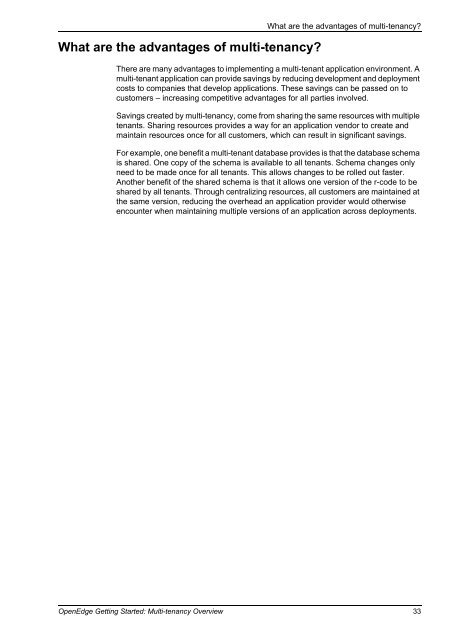OpenEdge Getting Started: Multi-tenancy Overview - Product ...
OpenEdge Getting Started: Multi-tenancy Overview - Product ...
OpenEdge Getting Started: Multi-tenancy Overview - Product ...
You also want an ePaper? Increase the reach of your titles
YUMPU automatically turns print PDFs into web optimized ePapers that Google loves.
What are the advantages of multi-<strong>tenancy</strong>?<br />
What are the advantages of multi-<strong>tenancy</strong>?<br />
There are many advantages to implementing a multi-tenant application environment. A<br />
multi-tenant application can provide savings by reducing development and deployment<br />
costs to companies that develop applications. These savings can be passed on to<br />
customers – increasing competitive advantages for all parties involved.<br />
Savings created by multi-<strong>tenancy</strong>, come from sharing the same resources with multiple<br />
tenants. Sharing resources provides a way for an application vendor to create and<br />
maintain resources once for all customers, which can result in significant savings.<br />
For example, one benefit a multi-tenant database provides is that the database schema<br />
is shared. One copy of the schema is available to all tenants. Schema changes only<br />
need to be made once for all tenants. This allows changes to be rolled out faster.<br />
Another benefit of the shared schema is that it allows one version of the r-code to be<br />
shared by all tenants. Through centralizing resources, all customers are maintained at<br />
the same version, reducing the overhead an application provider would otherwise<br />
encounter when maintaining multiple versions of an application across deployments.<br />
<strong>OpenEdge</strong> <strong>Getting</strong> <strong>Started</strong>: <strong>Multi</strong>-<strong>tenancy</strong> <strong>Overview</strong> 33
















